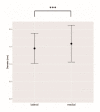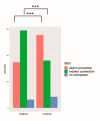Improving the Safety of DIEP Flap Transplantation: Detailed Perforator Anatomy Study Using Preoperative CTA
- PMID: 35629124
- PMCID: PMC9145001
- DOI: 10.3390/jpm12050701
Improving the Safety of DIEP Flap Transplantation: Detailed Perforator Anatomy Study Using Preoperative CTA
Abstract
Background: Deep inferior epigastric perforator and muscle sparing transverse rectus abdominis muscle flaps are commonly used flaps for autologous breast reconstruction. CT-angiography allows to analyse the perforator course preoperatively. Our aim was to compare the different aspects of perforator anatomy in the most detailed study. Methods: CT-angiographies of 300 female patients with autologous breast reconstruction of 10 years were analysed regarding the anatomy of the deep inferior epigastric artery and every perforator. Results: Overall, 2260 perforators were included. We identified correlations regarding the DIEA branching point and number of perforators and their intramuscular course. The largest perforator emerged more often from the medial branch of the DIEA than the smaller perforators (70% (416/595) vs. 54% (878/1634), p < 0.001) and more often had a direct connection to the SIEV (large 67% (401/595) vs. small 39% (634/1634), p < 0.01). Medial row perforators were larger than the laterals (lateral 1.44 mm ± 0.43 (n = 941) vs. medial 1.58 mm ± 0.52 (n = 1304) (p < 0.001)). The larger and more medial the perforator, the more likely it was connected to the SIEV: perforators with direct connection to the SIEV had a diameter of 1.65 mm ± 0.53 (n = 1050), perforators with indirect connection had a diameter of 1.43 ± 0.43 (n = 1028), perforators without connection had a diameter of 1.31 mm ± 0.37 (n = 169) (p < 0.001). Medial perforators were more often directly connected to the SIEV than lateral perforators (medial 56% (723/1302) vs. lateral 35% (327/941), p < 0.001). A lateral perforator more often had a short intramuscular course than medial perforators (69% (554/800) vs. 45% (474/1055), p < 0.001), which was also more often observed in the case of a small perforator and a caudal exit of the rectus sheath. Conclusion: The largest perforator emerges more often from the medial branch of the DIEA and frequently has a direct connection to the SIEV, making medial row perforators ideal for DIEP flap transplantation.
Keywords: CTA; DIEP flap; MS-TRAM flap; autologous breast reconstruction; perforator.
Conflict of interest statement
The authors declare no conflict of interest.
Figures








References
-
- Robert Koch Institut. Krebs in Deutschland für 2015/2016. [(accessed on 1 March 2020)]. Available online: https://www.krebsdaten.de/Krebs/DE/Content/Publikationen/Krebs_in_Deutsc....
-
- Chen K., Lu P., Beeraka N.M., Sukocheva O.A., Madhunapantula S.V., Liu J., Sinelnikov M.Y., Nikolenko V.N., Bulygin K.V., Mikhaleva L.M., et al. Mitochondrial mutations and mitoepigenetics: Focus on regulation of oxidative stress-induced responses in breast cancers. Semin. Cancer Biol. :2020. doi: 10.1016/j.semcancer.2020.09.012. in press. - DOI - PubMed
LinkOut - more resources
Full Text Sources

